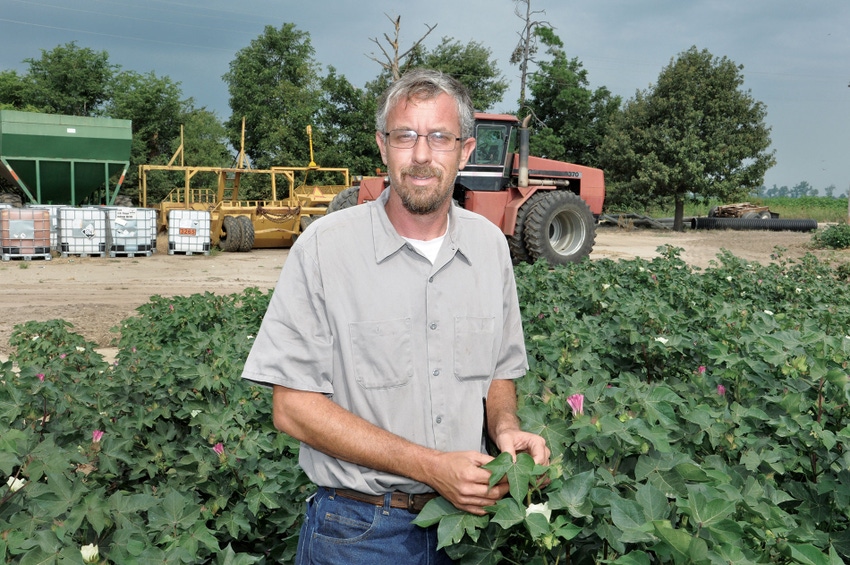
Developments in recent years could make fighting root knot nematodes a lot easier — and less costly — for Greg Lyerly, who farms 1,100 acres of cotton, 800 acres of corn, 1,000 acres of soybeans and 300 acres of wheat near Leachville, Ark.
The family farm has been battling root knot nematode in cotton as long as Lyerly can remember. His grandfather was an early adopter of fumigants for control of the pest, and did some of the first fumigant testing with the University of Arkansas in the mid-1950s. At that time, a blanket application of fumigant was the only way to go — and while it was cost-effective, it was also expensive.
When precision agriculture techniques came along, Mid-South cotton producers like Bruce Bond began experimenting with site-specific applications of fumigant to areas where nematodes were causing the most economic damage.
Recent research indicates that cotton sustains much higher levels of economic loss to root knot nematodes in sandier soils than in clay soils.
Armed with this knowledge, Lyerly has been gathering information to help him develop maps for site-specific applications of the fumigant Telone based on soil type.
Telone is a liquid injected into the ground pre-plant and then sealed so it will move throughout the soil. It controls all major species of nematodes, including root knot.
Lyerly’s soil structure makes data gathering a complex effort. “For us, soil may change in the top 6 inches of the profile, or it may change in the bottom 6 inches. We also have earthquake spurs with sand in them, and nematodes aren’t really driving the yield down in those spots. We need more data there.”
Significant cost reduction
Jerome Otto, Telone specialist for Dow AgroSciences, says site-specific applications of Telone can significantly increase a grower’s return on investment. “It isn’t uncommon to find, with site-specific applications, that growers are treating only half of a field. That’s a 50 percent reduction in their cost.”
For site-specific applications of Telone, he says, growers should first create soil maps of their fields, using an electrical conductivity mapping cart, such as a Veris rig, to map soil type.
After that, he recommends creating management zones — essentially areas at high or low risk for nematode injury.
“You verify the accuracy of those zones by analyzing soil samples for nematode counts,” Otto says. “It is critical to insure that zones of high risk and low risk are properly linked to the nematode populations.”
Next, create an application map that calls for a fumigant like Telone to be applied only to high risk zones. Then load the map into a GPS-equipped rig and make the application.
High-tech or low-tech
The application itself can be high-tech or low-tech, Otto says. “You can use a computer program to turn the Telone applicator on and off, or manually operate the system by closely watching the map as you go through the field.”
Lyerly believes that site-specific applications of Telone can pay, once the maps are created. “With site-specific applications, we think we can average 1 gallon per acre, versus 3 gallons per acre for a blanket application.”
“We’re getting close to developing the maps,” Lyerly says of the research being conducted on his farm by Dow AgroSciences and the University of Arkansas. “But resistant varieties may beat the technology to the field.”
He’s talking about new root knot nematode-resistant varieties from Monsanto/Deltapine and Dow AgroSciences/PhytoGen, which are proving to be effective in controlling root knot nematodes. The varieties don’t control reniform nematodes.
Root knot nematode resistance is available in two PhytoGen varieties in 2014: PHY 417 WRF and PHY 427 WRF, and in Deltapine’s DP 1454NR B2RF.
Traditionally-bred varieties
Root knot resistance in these varieties is the result of traditional breeding techniques, not genetic engineering. More varieties are expected to be released in the future.
Lyerly sees a lot of potential in these varieties. “Root knot-resistant varieties are comparable to Telone-treated cotton in yield, but don’t cost any more than any other cotton variety.”
He says site-specific applications of Telone and resistant varieties can cost-effectively be used together in parts of the same field. “The Telone would probably be applied in fewer, or smaller areas. In those situations, we might be applying an average of a quarter of a gallon of Telone per acre.”
This will mean further refinement of economic thresholds for site-specific Telone, he says. As far as data gathering is concerned, “We may have to start from scratch.”
In tests on Lyerly’s farm and two other locations in 2013, root knot-resistant varieties PHY 417 WRF and PHY 427 WRF significantly reduced the root-knot nematode gall rating versus susceptible cotton varieties. Also in three locations in 2013, Telone further reduced the gall rating for PHY 427 WRF, versus the same variety without Telone.
Yield was increased
Telone also increased yield by over 100 pounds for PHY 427 WRF, versus an untreated check of the same variety. All the tests were conducted in root knot nematode-infested fields.
Tests also concluded that galling on untreated PHY 427 WRF was equal to a Telone treatment on susceptible varieties, and that fall soil levels of root knot nematodes were lower in untreated PHY 427 WRF than when Telone was applied on susceptible varieties.
Otto believes that site-specific Telone has a place in the farmer’s nematode arsenal.
“I believe Telone will continue to be an effective tool, particularly for growers using site-specific applications. It significantly reduces their cost over the whole farm, and increases the return on their investment.
Some producers are reporting a positive impact from fumigation in the following year’s crop, Otto says.
According to Cotton Disease Loss Estimates, 2013, 651,700 bales were lost to nematodes in the U.S. in 2013 — 432,000 of those to root knot nematodes and 193,900 to reniform nematodes.
Nematodes can be introduced into a field by equipment, wildlife, wind, and water.
About the Author(s)
You May Also Like






